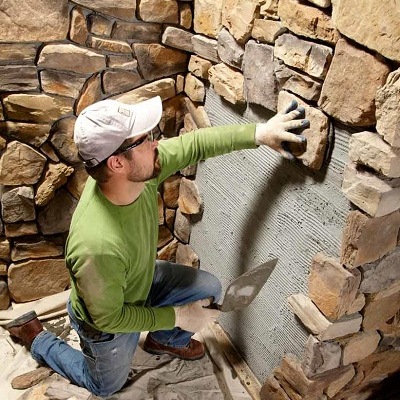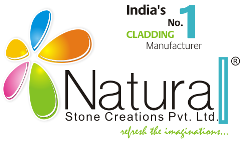
Installation Guide
To cut and size Stone-Veneer® all standard woodworking equipment can be used with carbide tooling. Table Saw; Router; Circular Saw; Laminate Trimmer; Miter Saw; Radial Arm Saw. For using panels with Stone-Veneer® on both sides, it is recommended to score them because the stone surface on the backside tends to slightly splinter. Follow all equipment manufactures safety rules.
The actual substrate it is to be applied to is almost unlimited. All wood and lightweight materials are suitable. If the Stone-Veneer® is only applied on one side of a carrier material, it is important to have a counter balance on the other side for stability. Mechanically mounted panels which have the Stone- Veneer® on one side, need a craft paper or foil backing of at least 150 g / m2 (3.6128 pound/cubic inch). If applied as floor or wall panels, different climate conditions have to be taken into consideration.
For any substrate you use there are a few standard guidelines to follow:
- The two products to be adhered together must be clean of dust, debris, grease and oils.
- Use a suitable adhesive for your substrate.We recommend Mapei S997 1K adhesive.
The Stone-Veneer® adhesive requirements vary with the factory backing used on the veneer.
Polyester backed (standard backing) and Fleece backed (optional) can be adhered with our recommended Mapei S997 1K product. If alternative un-recommended adhesives are used, from experience, sometimes these products can react with the backing material and cause problems.
When using a hot or cold hydraulic panel press to bond the Stone-Veneer® to a substrate it is recommended you use a soft “buffer” sheet (such as a thin rubber sheet) on the Stone-Veneer® because of the natural 3-Dimensional surface variances.
Care, Handling and Cleaning Guidelines for Stone-Veneer
1. Care and Handling
Stone-Veneer® is a real and natural slate product and it is as porous as any natural slate would be. The slate may absorb the oils found on your hands and fingers. Follow the cleaning instructions to remove any smudges. Wearing gloves when handling these materials will minimize the amount of cleaning required.
2. Cleaning
Any impurities splashed or spilled on the Stone-Veneer® should be removed as soon as possible. In doing so warm water and a lightly moistened lint free cloth often suffices. If the impurity or stain is not easily removed we recommend washing the surface with a soft lint free cloth moistened with a mild dish washing liquid and warm water solution. Alternatively, Mapei Cleaner L should be used and it is advised that a test area is done first.If you do use any additional cleaners, test them on an inconspicuous area first to make sure they will not adversely harm or stain the surface of the Stone-Veneer.
If the Stone-Veneer® is being used in any wet areas such as kitchen backsplashes, near a food preparation area or sink it does need to be sealed. Bacteria and everyday stains and dirt can accumulate in the slate’s pores making it difficult to clean. The natural minerals present in your water can also accumulate in the stone’s pores. This is most noticeable in bathroom applications and shower/bath areas.
There are a variety of stone sealers on the market today and when applied according to the manufacturer’s recommendations will seal the pores on the Stone-Veneer® surfaces. We have tested Tec™ EnsealantSB with very satisfactory results. It is a solvent based Stone Enhancer and Sealer.

